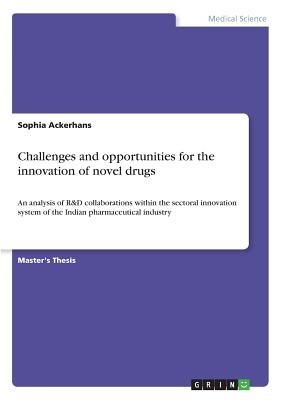
- We will send in 10–14 business days.
- Author: Elise Siebenbruck
- Publisher: GRIN Publishing
- Year: 2016
- ISBN-10: 3668237050
- ISBN-13: 9783668237056
- Format: 14.8 x 21 x 1 cm, minkšti viršeliai
- Language: English
- SAVE -10% with code: EXTRA
Challenges and opportunities for the innovation of novel drugs (e-book) (used book) | bookbook.eu
Reviews
Description
Master's Thesis from the year 2016 in the subject Medicine - Pharmacology, grade: 1,6, Copenhagen Business School, language: English, abstract: This paper investigates whether, and to what extent, external sourcing activities and R&D collaborations between Indian pharmaceutical firms and their partners in the sectoral innovation system constitute a viable option for them to upgrade into the development of new, enhanced drugs. This was achieved through conducting an analysis of the pharmaceutical industry's sector innovation system and R&D collaboration modes between Indian pharmaceutical firms and their external partners. The Indian pharmaceutical industry is the country's leading science-based industry with wide ranging capabilities in the complex field of drug technology and manufacturing. Expanding at a compound annual growth rate of 23.9 per cent, the Indian pharmaceuticals market is anticipated to reach USD 55 billion by 2020. Among the pharmerging markets, it is highly ranked in terms of quality and the extensive range of manufactured drugs. India signed the Agreement on Trade Related Intellectual Property Rights in 1995. This agreement aimed at harmonizing intellectual property rights and patent protection worldwide. India's decision to sign was disputed since civil society campaigners believed it would prevent access to low cost drugs and many Indian generics drug firms susptected to lose their right to reverse-engineer products, which were patent-protected abroad. Most small-scale generics firms remained resistant, while the majority of large-scale firms welcomed the possibility of entering higher-income markets, fuelled by their visions of becoming innovators themselves. Signing the Agreement on Trade Related Intellectual Property Rights necessitated amendments to the Patents Act, 1970. This Act had previously offered Indian firms equivalent protection to that of their foreign counterparts, encouraging them to produce new chemical entities instead of
EXTRA 10 % discount with code: EXTRA
The promotion ends in 22d.22:04:30
The discount code is valid when purchasing from 10 €. Discounts do not stack.
- Author: Elise Siebenbruck
- Publisher: GRIN Publishing
- Year: 2016
- ISBN-10: 3668237050
- ISBN-13: 9783668237056
- Format: 14.8 x 21 x 1 cm, minkšti viršeliai
- Language: English English
Master's Thesis from the year 2016 in the subject Medicine - Pharmacology, grade: 1,6, Copenhagen Business School, language: English, abstract: This paper investigates whether, and to what extent, external sourcing activities and R&D collaborations between Indian pharmaceutical firms and their partners in the sectoral innovation system constitute a viable option for them to upgrade into the development of new, enhanced drugs. This was achieved through conducting an analysis of the pharmaceutical industry's sector innovation system and R&D collaboration modes between Indian pharmaceutical firms and their external partners. The Indian pharmaceutical industry is the country's leading science-based industry with wide ranging capabilities in the complex field of drug technology and manufacturing. Expanding at a compound annual growth rate of 23.9 per cent, the Indian pharmaceuticals market is anticipated to reach USD 55 billion by 2020. Among the pharmerging markets, it is highly ranked in terms of quality and the extensive range of manufactured drugs. India signed the Agreement on Trade Related Intellectual Property Rights in 1995. This agreement aimed at harmonizing intellectual property rights and patent protection worldwide. India's decision to sign was disputed since civil society campaigners believed it would prevent access to low cost drugs and many Indian generics drug firms susptected to lose their right to reverse-engineer products, which were patent-protected abroad. Most small-scale generics firms remained resistant, while the majority of large-scale firms welcomed the possibility of entering higher-income markets, fuelled by their visions of becoming innovators themselves. Signing the Agreement on Trade Related Intellectual Property Rights necessitated amendments to the Patents Act, 1970. This Act had previously offered Indian firms equivalent protection to that of their foreign counterparts, encouraging them to produce new chemical entities instead of


Reviews